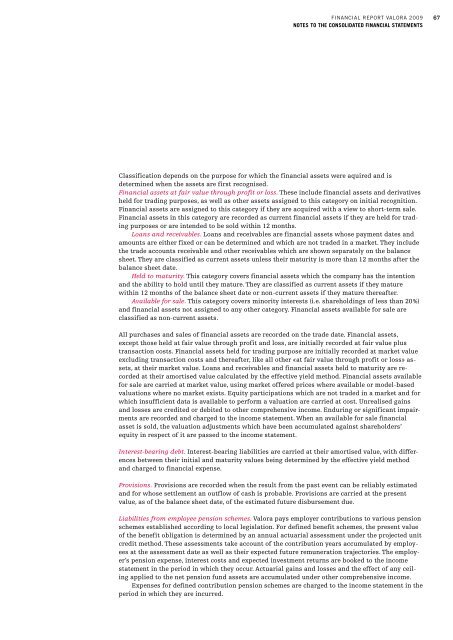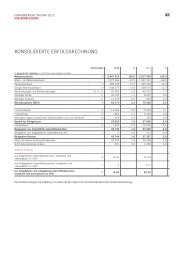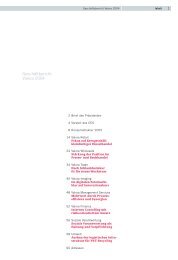PDF (3.6 MB) - Valora
PDF (3.6 MB) - Valora
PDF (3.6 MB) - Valora
Create successful ePaper yourself
Turn your PDF publications into a flip-book with our unique Google optimized e-Paper software.
Financial RepoRt ValoRa 2009<br />
notEs to tHE consolIdatEd fInancIal statEmEnts<br />
Classification depends on the purpose for which the financial assets were aquired and is<br />
determined when the assets are first recognised.<br />
Financial assets at fair value through profit or loss. These include financial assets and derivatives<br />
held for trading purposes, as well as other assets assigned to this category on initial recognition.<br />
Financial assets are assigned to this category if they are acquired with a view to short-term sale.<br />
Financial assets in this category are recorded as current financial assets if they are held for trading<br />
purposes or are intended to be sold within 12 months.<br />
Loans and receivables. Loans and receivables are financial assets whose payment dates and<br />
amounts are either fixed or can be determined and which are not traded in a market. They include<br />
the trade accounts receivable and other receivables which are shown separately on the balance<br />
sheet. They are classified as current assets unless their maturity is more than 12 months after the<br />
balance sheet date.<br />
Held to maturity. This category covers financial assets which the company has the intention<br />
and the ability to hold until they mature. They are classified as current assets if they mature<br />
within 12 months of the balance sheet date or non-current assets if they mature thereafter.<br />
Available for sale. This category covers minority interests (i.e. shareholdings of less than 20%)<br />
and financial assets not assigned to any other category. Financial assets available for sale are<br />
classified as non-current assets.<br />
All purchases and sales of financial assets are recorded on the trade date. Financial assets,<br />
except those held at fair value through profit and loss, are initially recorded at fair value plus<br />
transaction costs. Financial assets held for trading purpose are initially recorded at market value<br />
excluding transaction costs and thereafter, like all other «at fair value through profit or loss» assets,<br />
at their market value. Loans and receivables and financial assets held to maturity are recorded<br />
at their amortised value calculated by the effective yield method. Financial assets available<br />
for sale are carried at market value, using market offered prices where available or model-based<br />
valuations where no market exists. Equity participations which are not traded in a market and for<br />
which insufficient data is available to perform a valuation are carried at cost. Unrealised gains<br />
and losses are credited or debited to other comprehensive income. Enduring or significant impairments<br />
are recorded and charged to the income statement. When an available for sale financial<br />
asset is sold, the valuation adjustments which have been accumulated against shareholders’<br />
equity in respect of it are passed to the income statement.<br />
Interest-bearing debt. Interest-bearing liabilities are carried at their amortised value, with differences<br />
between their initial and maturity values being determined by the effective yield method<br />
and charged to financial expense.<br />
Provisions. Provisions are recorded when the result from the past event can be reliably estimated<br />
and for whose settlement an outflow of cash is probable. Provisions are carried at the present<br />
value, as of the balance sheet date, of the estimated future disbursement due.<br />
Liabilities from employee pension schemes. <strong>Valora</strong> pays employer contributions to various pension<br />
schemes established according to local legislation. For defined benefit schemes, the present value<br />
of the benefit obligation is determined by an annual actuarial assessment under the projected unit<br />
credit method. These assessments take account of the contribution years accumulated by employees<br />
at the assessment date as well as their expected future remuneration trajectories. The employer’s<br />
pension expense, interest costs and expected investment returns are booked to the income<br />
statement in the period in which they occur. Actuarial gains and losses and the effect of any ceiling<br />
applied to the net pension fund assets are accumulated under other comprehensive income.<br />
Expenses for defined contribution pension schemes are charged to the income statement in the<br />
period in which they are incurred.<br />
67






